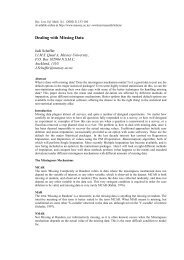Mathematical Modelling of Granulation: Static and Dynamic Liquid ...
Mathematical Modelling of Granulation: Static and Dynamic Liquid ...
Mathematical Modelling of Granulation: Static and Dynamic Liquid ...
You also want an ePaper? Increase the reach of your titles
YUMPU automatically turns print PDFs into web optimized ePapers that Google loves.
202 R.L.I.M.S. Vol. 3, April, 2002<br />
φ<br />
100<br />
80<br />
60<br />
40<br />
20<br />
0<br />
−20<br />
−40<br />
−60<br />
−80<br />
0.5<br />
0.4<br />
0.3<br />
0.1<br />
0.2<br />
0<br />
−100<br />
0 0.5 1 1.5 2 2.5<br />
R ∆ P<br />
3 3.5 4 4.5 5<br />
where<br />
<strong>and</strong><br />
−1<br />
−2<br />
−3<br />
−4<br />
−5<br />
−6<br />
−7<br />
Figure 2: Phase portrait for ∆P >0. Hereφ = arctan R ′ . Contour labels are values <strong>of</strong> E ∆P .<br />
η 2 ,ξ 2 =<br />
2<br />
(∆P ) 2<br />
<br />
(1 − E∆P ± √ <br />
1 − 2E∆P<br />
ξ = χ/η<br />
such that ξ ≤ R ≤ η,<strong>and</strong>where E <strong>and</strong> F are Jacobi elliptic functions <strong>of</strong> the first kind [9]. Equation (11) defines<br />
the shape (R) <strong>of</strong>abridge parameterised by the position X, wheretheenergylevels E are determined<br />
from (8). Upon consideration <strong>of</strong> the discriminant <strong>of</strong> the the quadratic in X 2 <strong>of</strong> (9), it can be shown that<br />
E ∆P < 1<br />
2 .<br />
Although equation (11) represents the liquid bridge configuration in terms <strong>of</strong> known mathematical functions,<br />
difficulty arises when attempting to integrate this solution to determine properties such as the bridge surface<br />
area <strong>and</strong> volume. In order to solve the problem in which certain properties are held constant, approximations<br />
to the bridge surface, or a numerical scheme, must be used (as in [2-6]).<br />
Phase Portrait<br />
The energy level E is related to the height <strong>and</strong> slope <strong>of</strong> the bridge surface (R, R ′ )byequation (8). Boundary<br />
conditions on R <strong>and</strong> R ′ , along with the pressure difference ∆P determine the contour for a particular liquid<br />
bridge. Generic contours, characterising all liquid bridge configurations, can be obtained from (8) by scaling.<br />
Upon introducing ˜ R = R ∆P <strong>and</strong> ˜ X = X ∆P ,itfollows that<br />
E ∆P = ˜ ⎛<br />
R ⎝<br />
1<br />
<br />
1+ ˜ R ′2<br />
− ˜ ⎞<br />
R<br />
⎠ .<br />
2<br />
(12)<br />
An angle φ measured with respect to the horizontal coordinate X is introduced where R ′ <br />
= tan φ <strong>and</strong> therefore<br />
1+R ′2<br />
= sec φ. Interms <strong>of</strong> φ,equation (12) becomes<br />
E ∆P = ˜ <br />
R cos φ − ˜ <br />
R<br />
2<br />
for ∆P >0, (13a)








